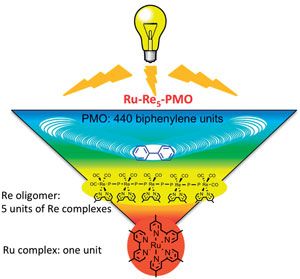April 7, 2014
Japanese Researchers Develop Man-Made Leaves that Harvest Light
Keywords: Environmental Technology University / Research institute

Coppyright Tokyo Institute of Technology All Rights Reserved.
The Tokyo Institute of Technology (Tokyo Tech) announced on January 9, 2014, success in developing man-made leaves to harvest light, jointly with Toyota Central R&D Labs. This success will lead to realization of artificial photosynthesis, with an efficiency of converting solar energy to chemical energy comparable to that of natural photosynthesis.
The system of natural photosynthesis consists of two steps: harvesting solar light on the surface of leaves and concentrating it into a chlorophyll aggregate via energy transfer, and then integrating it to a reaction center where the oxidation-reduction reaction starts. The newly developed system also consists of two steps, like the natural one.
The research team combined periodic mesoporous organosilica (PMO) tubes developed by Toyota Labs and a metal complex developed by Tokyo Tech. The PMO has many organic molecules that absorb light, and that light energy captured it is concentrated first to five rhenium complexes, and finally to a single ruthenium complex that works as the reaction center.
The researchers plan to merge the new system with carbon dioxide reduction and recycling, as well as water oxidation photocatalysis, to generate hydrogen, hoping that this leads to realization of artificial photosynthesis to convert solar energy to chemical energy efficiently. This will lead to a decrease in the use of the photocatalyst.
Related
"JFS Newsletter"
Related
"Popular Articles"
- New Nano-Bubble Technology May Help Dissolve Sludge and Improve Water Quality
- Japanese Firm Begins Development of Tidal Power Generation System
- Small Hydropower Generation System Developed for Use in Seawater, Weight Cut by Half
- Constructed Wetland Facility Established by Japanese University Purifies Livestock Farming Drainage
- Toyota CRDL Succeeds in World's First Artificial Photosynthesis Using only Water and CO2


